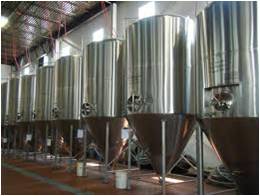Fermentation in beer production
Back to EFFICIENCY FINDER OF FOOD INDUSTRY
General Description
There are three main fermentation methods in brewing, warm, cool and wild or spontaneous. Fermentation may take place in open or closed vessels. There may be a secondary fermentation which can take place in the brewery, in the cask or in the bottle. Brewing yeasts are traditionally classed as "top-fermenting" and "bottom-cropping". Yeast were termed top or bottom cropping, because in traditional brewing, the yeast was collected from the top or bottom of the fermenting wort to be reused for the next brew. As brewing methods changed in the 20th century, cylindro-conical fermenting vessels became the norm and the collection of yeast is now done from the bottom of the fermenter, thus the method of collection no longer implies a species association. There are a few remaining breweries who collect yeast in the top-cropping method, such as Samuel Smiths brewery in Yorkshire, Marstons in Staffordshire and several German wheat beer producers.
Fermentation is the process by which yeast converts the glucose in the wort to ethyl alcohol and carbon dioxide gas - giving the beer both its alcohol content and its carbonation. To begin the fermentation process, the cooled wort is transferred into a fermentation vessel to which the yeast has already been added. Since fermentation produces a substantial amount of heat, the tanks must be cooled constantly to maintain the proper temperature.
Application
Beer
Typical Parameters
Warm fermentation (e.g British Ales) In general, yeasts such as Saccharomyces cerevisiae are fermented at warm temperatures between 15 and 20°C (59 and 68°F), occasionally as high as 24°C (75°F). ] They generally form foam on the surface of the fermenting beer. Generally, warm-fermented beers are ready to drink within three weeks after the beginning of fermentation (the actual fermentation will take around 2 weeks), although some brewers will condition them for several months. Cool fermentation (e.g. Lagers) Lager is beer that has been cool fermented at around 10°C (50 °F) or lower (compared to typical warm fermentation temperatures of 18 °C (64 °F)), then stored for around 30 days at temperatures close to freezing point. During this storage, sulphur components developed during fermentation dissipate Spontaneous fermentation Lambic beers are historically brewed in Brussels and the nearby Pajottenland region of Belgium without any yeast inoculation. They are fermented in oak barrels with the resident microbiota present in the wood and can take up to 2 years to come into condition for sale.
